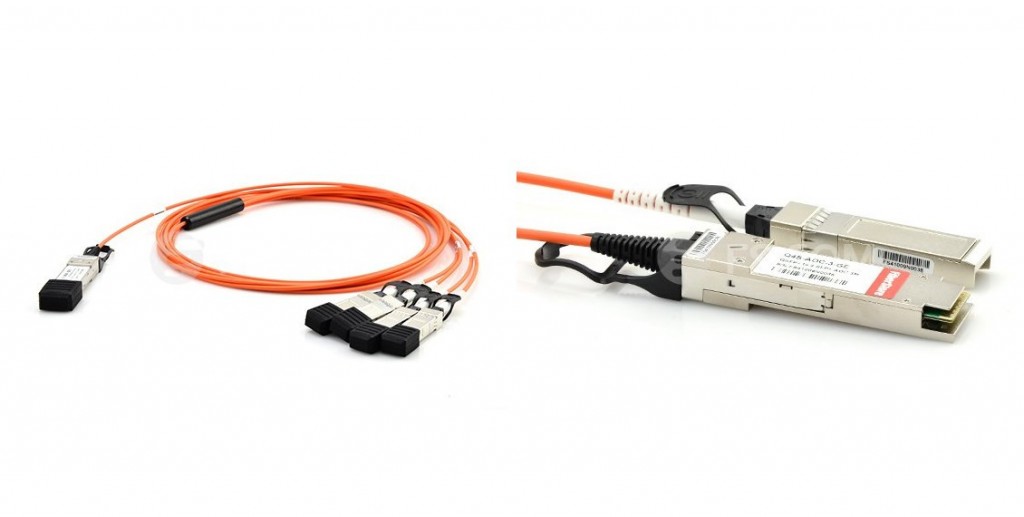May 11, 2016
40GbE (Gigabit Ethernet) is an Ethernet standard developed by the IEEE 802.3ba task force. It enables the transfer of Ethernet frames at speeds of up to 40 gigabits per second (Gbps) and addresses physical layer specifications for communication across backplanes, copper cabling, multimode fiber and single-mode fiber. 40GbE standard has now been a new generation of high-speed and high-demand computing applications. Like 1GbE and 10GbE networks, the heart of the 40GbE network layer is a pair of transceiver modules which are connected by a patch cable. Transceiver modules and patch cables seem to be two basic components for 40GbE transmission. In this post, those two kinds of components for 40GbE transmission will be introduced.
40GbE transceivers are being developed along several standard form factors.
CXP TransceiverThe CXP form factor transceiver provides twelve lanes in each direction. It has a smaller size than the CFP transceiver. CXP transceiver serves the needs of multimode optics and copper. The Roman number "X" means that each channel has a transmission rate of 10 Gbps. CXP is a kind of hot-pluggable transceiver with data rate up to 12×10 Gbps.
CFP TransceiverThe CFP (C form-factor pluggable) transceiver also features twelve transmit and twelve receive 10Gbps lanes to support one 100GbE port, or up to three 40GbE ports. It is suitable for the needs of single-mode optics and can easily serve multimode optics or copper as well.
QSFP/QSFP+ TransceiverThe QSFP/QSFP+ (quad small-form-factor pluggable) transceiver has similar size with the CXP transceiver. It provides four transmit and four receive lanes to support 40GbE applications for multi-mode and single-mode fiber and copper today. QSFP+ transceiver is the most popular interface of 40G transceivers now. Two main types of QSFP+ transceivers are commonly used in the data center: short reach (QSFP-40G-SR4) for ~100 meters transmission on multimode fiber and long reach (QSFP-40G-LR4) for 100 meters to 10km using single-mode fiber. And there are other types of QSFP+ modules according to different objectives, such as 40GBASE-ER4, 40GBASE-LX4 (like JNP-QSFP-40G-LX4), 40GBASE-PLRL4 QSFP+, etc.
Fiber optic cable and copper cable are two mainly cabling choices for 40 GbE. OM3 and OM4 multi-mode fiber optic cables are generally recommended for 40GbE data center applications. They support a wider range of deployment configurations compared to copper cabling. The cost of using OM3 and OM4 multimode cabling solution is lower than the single-mode cabling solution. The supportable channel length depends on the cable and the transceiver type. With regard to connectors, MPO/MTP connectors for multimode transceivers can support multifiber parallel optics channels.
DAC and AOCDirect attach copper cable (DAC) and active optical cable (AOC) are ideal solutions for short-distance interconnection. They are widely used in data centers. Especially 40G QSFP+ breakout cables, with various of advantages compared with copper solutions and transceiver modules, are cost-effective solutions for 40GbE.
40G DAC includes active DACs and passive DACs. 40GbE passive copper cables provide robust connections for 40G systems and have low power consumption which improves data center power consumption and thermal efficiency, which makes them ideal for 40G LAN, HPC and SAN applications. QSFP+ to QSFP+ passive copper cable and QSFP+ to 4SFP+ passive breakout copper cable (such as QSFP-4SFP10G-CU3M) are two common types of QSFP+ passive DAC cables. 40G AOC is a type of active optical cable for 40GbE applications that is terminated with 40GBASE QSFP+ transceiver on one end while on the other end, it can be terminated with QSFP+ connector, SFP+ connector, or LC/SC/FC/ST connector. QSFP+ AOC integrates four data lanes in each direction with 40Gbps aggregate bandwidth. Each lane can operate at 10Gbps with lengths ranging from one to 100m. It is compliant with the QSFP MSA and IEEE P802.3ba. The following picture shows a Cisco QSFP-4X10G-AOC5M compatible 40G QSFP+ to 4x10G SFP+ active optical cable.

Unlike traditional Ethernet standard which has relied upon duplex fiber cabling with each channel using one fiber to transmit and the other to receive, 40GbE standard uses parallel optics for transmission. A 12-fiber cabling solution with each channel featuring four dedicated transmit fibers and four dedicated receiver fibers is used for 40GbE. The middle four fiber generally remain unused.
40GbE optics now are popular in data center and the market of 100GbE is accelerating. As products become less expensive and more available over time, 40 GbE and 100 GbE will evolve and become more popular in the next three to seven years. This post provides a quick and simple overview of 40GbE fiber optic components of the interconnected foundation. Hopes it can help you have a general idea of 40GbE.
Posted by: jowang at
06:03 AM
| No Comments
| Add Comment
Post contains 773 words, total size 6 kb.
35 queries taking 0.0165 seconds, 70 records returned.
Powered by Minx 1.1.6c-pink.









